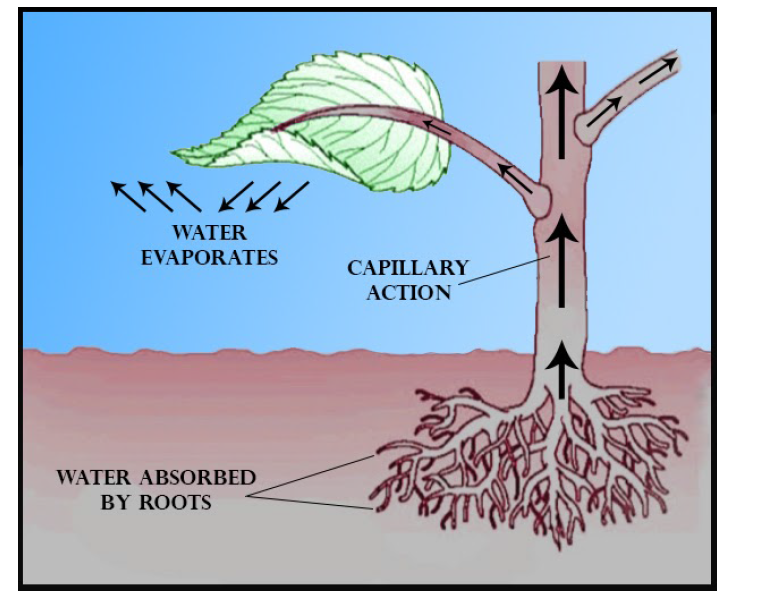
What is transpiration? Explain various factors affecting it.
Answer
498.3k+ views
Hint: Plants perform processes like diffusion for the transfer of water and other substances but diffusion is not sufficient in the case of long plants. So, they adopted a mechanism in which they evaporate water to pull it upwards.
Complete answer:
Transpiration is the loss of water from aerial parts of the plants mostly from leaves in the form of water vapor.
Transpiration may occur through the stomata, cuticle, or lenticels of plants. Based on this transpiration is of three types.
- Cuticular Transpiration
The cuticle is a wax- like layer covering the epidermis of leaves and some stems. The cuticle is meant to check transpiration but some of the water is lost through it too. The loss of water in the form of water vapor through a cuticle is known as cuticular transpiration.
- Lenticular Transpiration
A lenticel is an opening in the bark of stems and roots that allows mainly gases to be exchanged. The loss of water in the form of water vapor through lenticel is known as lenticular transpiration.
- Stomatal Transpiration
Stomata are the special structures that are responsible for the transfer of gases between the plant and the environment. The loss of water in the form of water vapor through stomata is known as stomatal transpiration. Stomata is responsible for 90% of transpiration by the plant.

TRANSPIRATION
Factors Affecting Transpiration are:
External factors
- Light - Plants respire more rapidly in the light than in the dark. This is because light stimulates the opening of the stomata.
- Temperature - Plants respire more rapidly at a higher temperature because water evaporates more rapidly when the temperature is high.
- Humidity - Increases humidity decreases transpiration as air is already saturated with water.
Internal factors
- Internal factors that affect transpiration are the number of stomata, leaf area, the thickness of the cuticle, etc.
Note: In a dicot leaf, the lower surface of the leaf has a comparatively more number of stomata than on the upper surface of the leaf. In monocot leaf, the upper and lower surface has an equal number of stomata distributed. The exudation of xylem sap in the form of liquid droplets from the tips or edges of the leaves is known as guttation.
Complete answer:
Transpiration is the loss of water from aerial parts of the plants mostly from leaves in the form of water vapor.
Transpiration may occur through the stomata, cuticle, or lenticels of plants. Based on this transpiration is of three types.
- Cuticular Transpiration
The cuticle is a wax- like layer covering the epidermis of leaves and some stems. The cuticle is meant to check transpiration but some of the water is lost through it too. The loss of water in the form of water vapor through a cuticle is known as cuticular transpiration.
- Lenticular Transpiration
A lenticel is an opening in the bark of stems and roots that allows mainly gases to be exchanged. The loss of water in the form of water vapor through lenticel is known as lenticular transpiration.
- Stomatal Transpiration
Stomata are the special structures that are responsible for the transfer of gases between the plant and the environment. The loss of water in the form of water vapor through stomata is known as stomatal transpiration. Stomata is responsible for 90% of transpiration by the plant.

TRANSPIRATION
Factors Affecting Transpiration are:
External factors
- Light - Plants respire more rapidly in the light than in the dark. This is because light stimulates the opening of the stomata.
- Temperature - Plants respire more rapidly at a higher temperature because water evaporates more rapidly when the temperature is high.
- Humidity - Increases humidity decreases transpiration as air is already saturated with water.
Internal factors
- Internal factors that affect transpiration are the number of stomata, leaf area, the thickness of the cuticle, etc.
Note: In a dicot leaf, the lower surface of the leaf has a comparatively more number of stomata than on the upper surface of the leaf. In monocot leaf, the upper and lower surface has an equal number of stomata distributed. The exudation of xylem sap in the form of liquid droplets from the tips or edges of the leaves is known as guttation.
Latest Vedantu courses for you
Grade 10 | MAHARASHTRABOARD | SCHOOL | English
Vedantu 10 Maharashtra Pro Lite (2025-26)
School Full course for MAHARASHTRABOARD students
₹33,300 per year
Recently Updated Pages
Master Class 11 Economics: Engaging Questions & Answers for Success

Master Class 11 Business Studies: Engaging Questions & Answers for Success

Master Class 11 Accountancy: Engaging Questions & Answers for Success

Master Class 11 English: Engaging Questions & Answers for Success

Master Class 11 Computer Science: Engaging Questions & Answers for Success

Master Class 11 Maths: Engaging Questions & Answers for Success

Trending doubts
State and prove Bernoullis theorem class 11 physics CBSE

1 ton equals to A 100 kg B 1000 kg C 10 kg D 10000 class 11 physics CBSE

State the laws of reflection of light

One Metric ton is equal to kg A 10000 B 1000 C 100 class 11 physics CBSE

1 Quintal is equal to a 110 kg b 10 kg c 100kg d 1000 class 11 physics CBSE

Difference Between Prokaryotic Cells and Eukaryotic Cells




